N0RQ’s 2011 grid expedition page
We did a very short grid expedition to DM86 in May 2011. It was primarily a family vacation trip, so operating time was be very limited, but we did put a small handful of stations in the log. Click to see a map of the rarest grids. TRIP RESULTS down below…
Details (pre-trip):
| planned dates |
NOTE: time on air will be very limited… |
|
| bands | 6m only | |
| callsign used | NT5HS (a club callsign for which I’m trustee) | |
| grids |
|
|
| modes | SSB if band open, FSK441 in early AM | |
| priorities | when E-skip is going strong enough, SSB Qs will take priority over the much-slower FSK441 | |
| freq: SSB | monitor 50.125 for E-skip openings; if busy, QSY to 50.175 (planned) or so | |
| freq: meteor scatter (WSJT homepage, also see WSJT Yahoo Group) |
FSK441 (& ISCAT?) will be 50.260: CQ 252 NT5HS DM86, me 1st, ST on, report, and I’ll either skip the 73 or only send it once; after a QSO on 50.252, I’ll CQ & listen on 252 for a few minutes, then to back to 260 and CQ as described above — if you are new to meteor scatter, first, welcome!, and second, please make sure you understand proper QSO procedures (read the “read this” and “also this” on the PingJockey page); also use F5 (Help / What Message to Send?) in the WSJT software — that is a very common point of confusion — if you don’t understand the CQ text in brown above, you need to before attempting a QSO — for assistance, join the WSJT Yahoo Group, a great group of knowledgeable and friendly folks, amd make sure to see the MeteorScatter.org site! | |
| pointing the antenna |
|
|
| rigs | will probably have 2 Kenwood TS-480/SATs, one to run with, and the other to listen for SSB (Es) openings (and so that I have a backup rig just in case one loses its smoke) | |
| power output | really would like 300+ watts, but budget doesn’t allow for an amp, so it will be 100 watts — would like a TE Systems, but maybe another year — if someone wants to lend me a 6m TE Systems amp (or sell one cheap), let’s chat | |
| antennas | had hoped to take 5 element M2 6M5X beam, but not feasible this time, so will be 3-element 6m beam at ~25′ on a Rohn H40 mast; also a Par Electronics 6m loop or a 1/4 wave vertical on the roof of the vehicle (for SSB listening/traveling) | |
| power for equipment | probably have a couple of batteries, with charging via vehicle | |
| QSL info | QSL direct to NT5HS (SASE, please); QSOs will be uploaded to LOTW | |
OTHER NOTES:
- probably will not have internet access a majority of the time, so probably limited PingJockey , but will TRY to do PingJockey whenever possible
- MAY not have cell phone coverage while on grid line of DM85/DM86
- I don’t expect to have (much) email capability, either, except perhaps at hotels in the evening
- APRS will be on-board — it may be out of range some of the time, but you can look for NT5HS-3
- will have HF capability (20m & 40m phone), but don’t plan to use it unless there is some specific purpose in doing so
- appropriate photo and video documentation of grid locations will be made and posted at the bottom of this page AFTER the trip
In advance: I’M SORRY if you called and we didn’t work. I know how it goes. I wasn’t ignoring anyone or any direction on purpose. This was primarily a family trip, not a grid expedition, so operating times were very limited and not very flexible. Thanks for your understanding.
73, Dave, N0RQ
RESULTS
Comments:
It was my first time setting up /portable for VHF, so I didn’t do everything right. For future grid expeditions (mine and others), and for a tad of humor, here are my lessons learned:
- *** from May 13:
- Try not to park tipped – or you’ll sit in the chair of the vehicle sideways for some hours. [sigh]
- I didn’t space my ground anchors very well – one direction (which happened to be the direction from which the wind blew) didn’t have enough support, so the mast tended to lean. (Embarrassing pictures/video below.)
- It gets windy after sunrise in west Texas.
- Setting up in the dark (and cold) is harder and takes longer than the practice session.
- Having a 17 year old ham/daughter who volunteers to get up by 4:30am to go out and help is invaluable. Thank you Sarah, KE5CIJ !!! (And she learned some about operating high-speed meteor scatter as well.)
- The $7.50 ground anchors from Home Depot work good – and make sure to have a 2’ pipe or rebar to use to help screw them in. And having a 4th one just in case is probably wise (I didn’t, but I will).
- The old 3-element 6m beam (which I considered the weakest link in my setup) seemed to work pretty good. Although I’d prefer the 5 element 6M5X, the smaller one sure transports easier – and it was pointed in the “wrong” direction less than the 5-el would have. Next time, I’m taking both of them with me!
- When people drive by, they sure look at you funny.
- Guys that install UHF telemetry equipment (complete with a pile of 900MHz Yagis in the back of the pickup) are curious enough to stop and chat.
- Chatting in the middle of a FSK441 QSO probably isn’t the greatest idea.
- I should have put a copy of the QRZ database on my laptop (which is not my normal ham computer), so that I could have better aimed the antenna for stations not in the WSJT lookup file.
- Power line noise is most likely to be found right at the grid line location you hoped to operate from. LLL
- My power inverter makes noise on 6m. L
- I should have had a DC adapter for my laptop, instead of relying on the AC adapter fed by the inverter.
- I need a much better way to rotate the beam on top of the Rohn H40 mast. I had intended to simply turn the mast by hand when needed – which sort-of worked. But the guy ropes gripped a bit more than I expected, and the wind was windier than I expected, so I wasn’t always looking exactly where I wanted. (Having 3 elements instead of 5 helped reduce the negative impact of that.) I have an old TV rotor I might try to use next time.
- DM86 really is a much-needed grid. And pretty barren. And windy. Pics & video below.
- *** and from the return trip on May 21:
- The local police captain is a curious and very friendly guy — and likes to brag about Dalhart! J
- Sarah noted that when men drive by, they stare, but when women drive by, they barely glance at the odd setup.
- Even with my WiFi cantenna with extended 802.11 range, it is still impossible to find an open WiFi connection on the south edge of Dalhart, TX — meaning no PingJockey.
- Hotel rates in small west Texas towns are not always cheap!
QSO stats:
on 5/13, we made 15 FSK441 QSOs from DM86sa
on 5/21, we make 7 FSK441 and 1 ISCAT QSO from DM86sa (Sarah did most of these)
on 5/21, 6m opened a bit, so we made 11 SSB contacts from DM86 was we headed to a wedding in Tulsa
on 5/21 & 5/22, also made a couple dozen 6m SSB QSOs from DM96 and other various grids in Oklahoma
Pictures of grid-expedition setup and GPS:
First, from May 13:
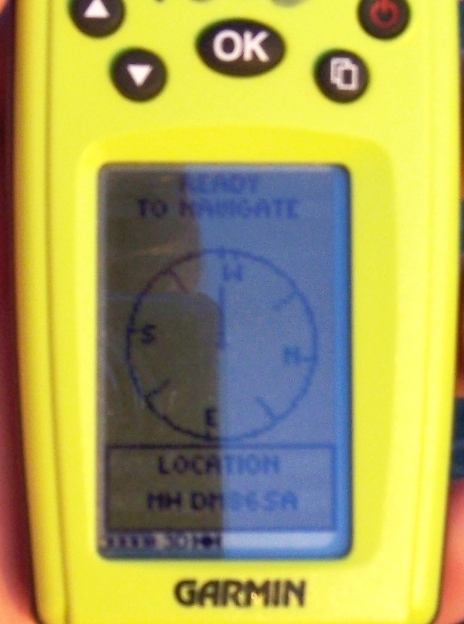
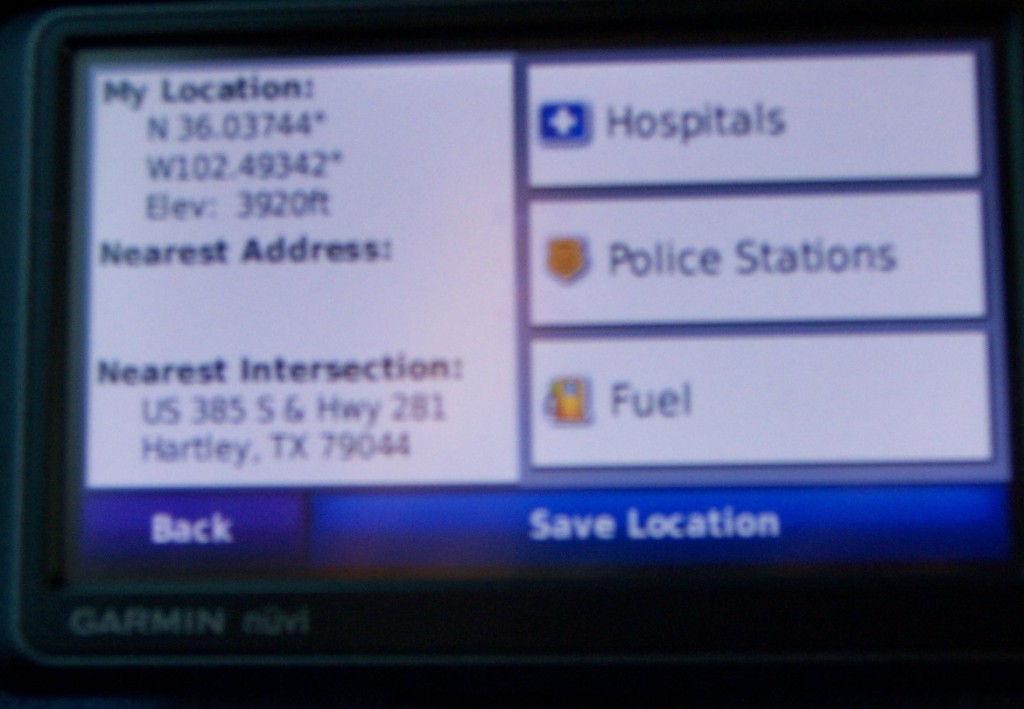
DM86 !!!
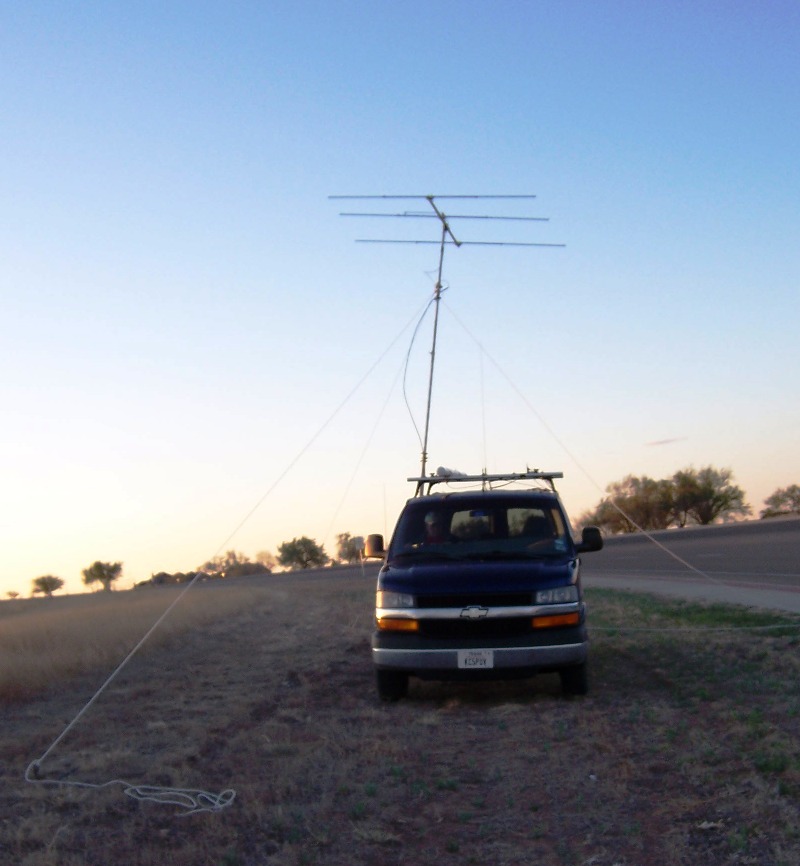
Yeah, I know, the mast is tipped — I’m slightly embarrassed — but I learned, and will do better next time! 🙂
(At least it didn’t fall down, and it did seem to work pretty good! And no, it is not attached to the van. The rear tire is parked on a piece of heavy steel (picture below), with a bolt sticking up, and the mast goes over the bolt to stop the base of the mast from moving, and to make erecting the mast easier and safer.)
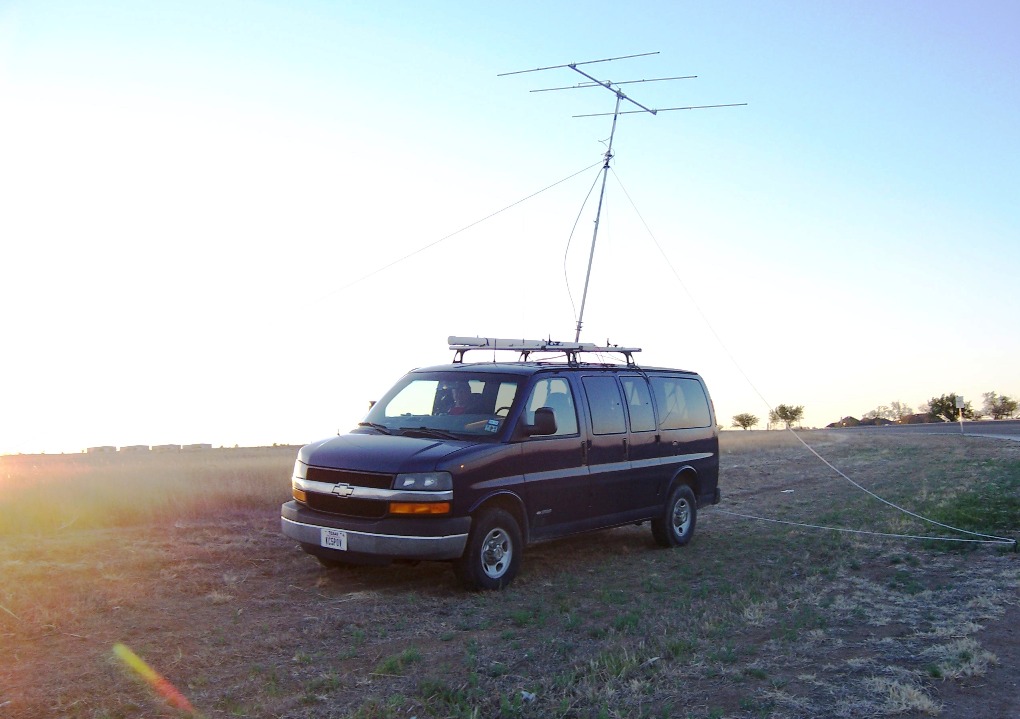
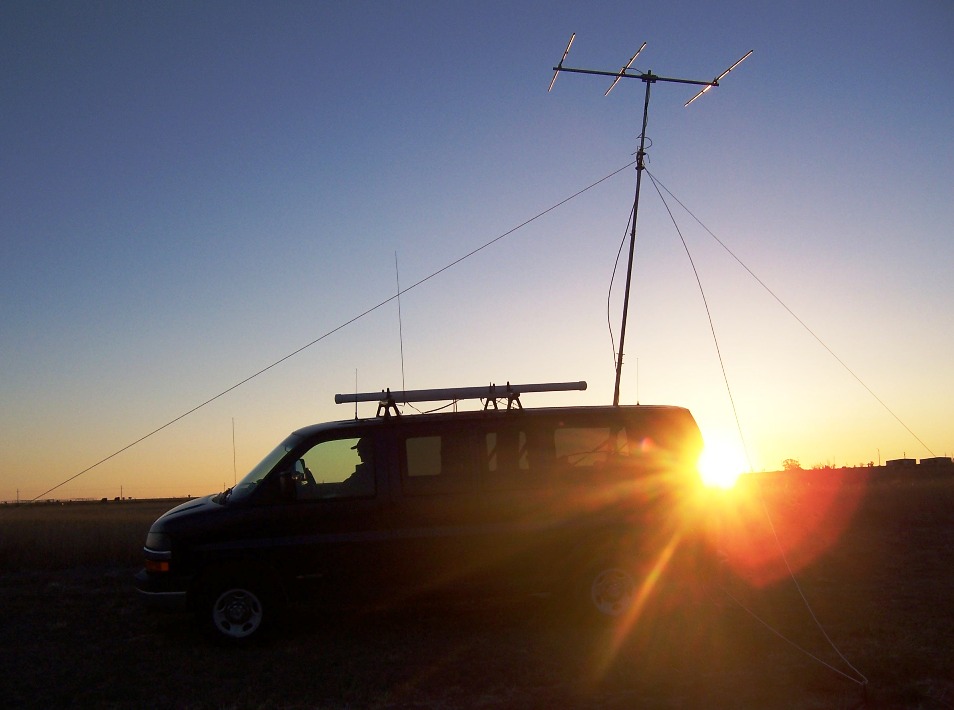
OK, here are some pics from the trip back to DM86 (on the way home from CO, May 21) — and hey, we got the mast straight up and down this time!
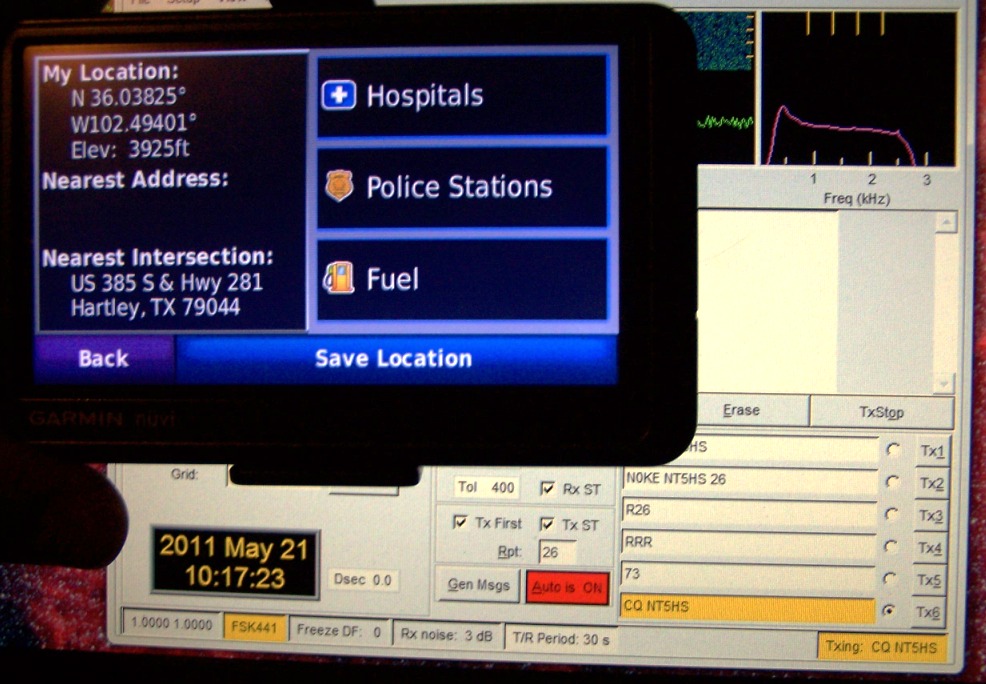
Yep, DM86sa, on the south edge of Dalhart Texas (“Hartley” is 13 miles down the road). This Google map of these coordinates shows us south of Dalhart, on FM 281, just west of US 87 — which is exactly where we were.
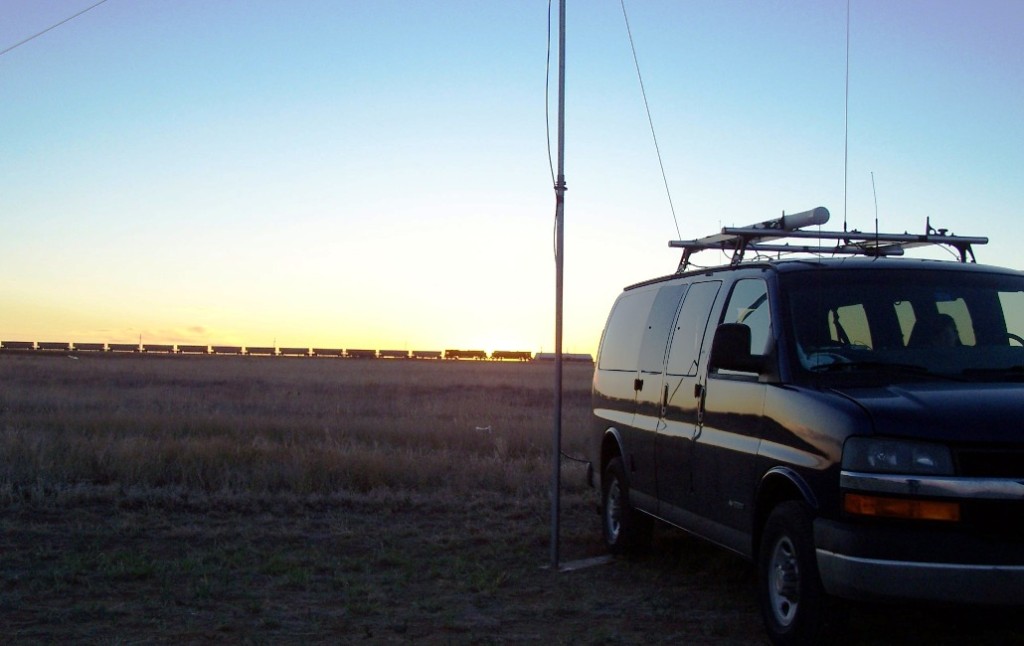
(they like trains in Dalhart, TX — train after train, hauling coal and some sort of seed or grain…)
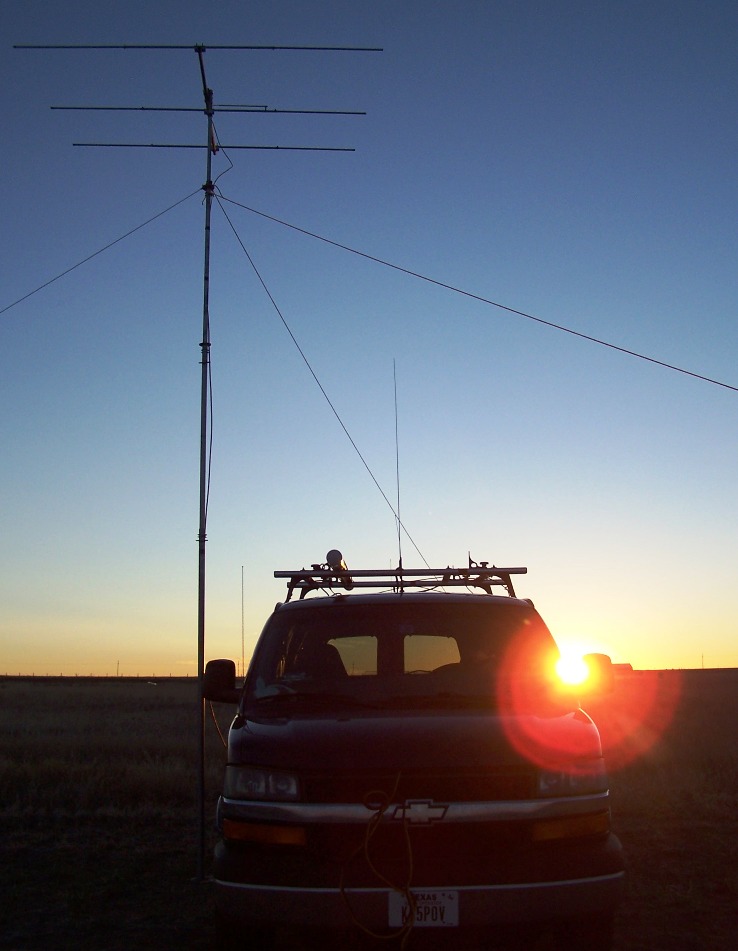
Sunrise on May 21… (that’s a 1/4 wave 6m vertical on the roof, along with a dual-band vertical for 2m/70cm FM, and a 1/4 wave 2m vertical for APRS)
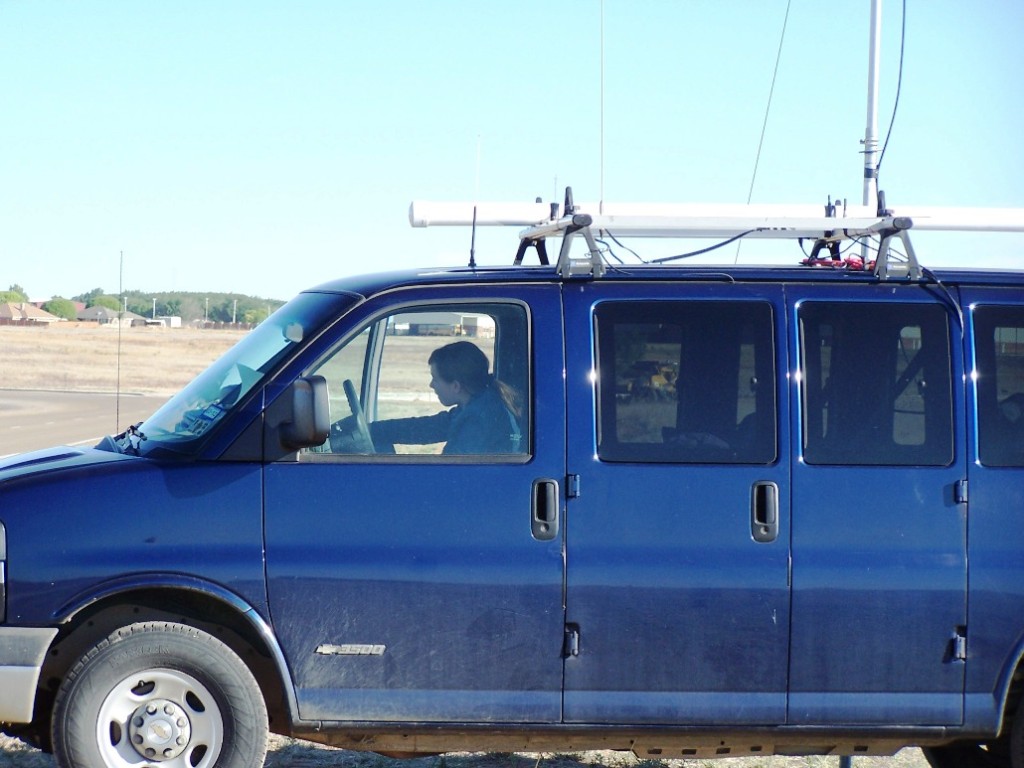
Sarah KE5CIJ making FSK441 QSO while N0RQ took pictures…
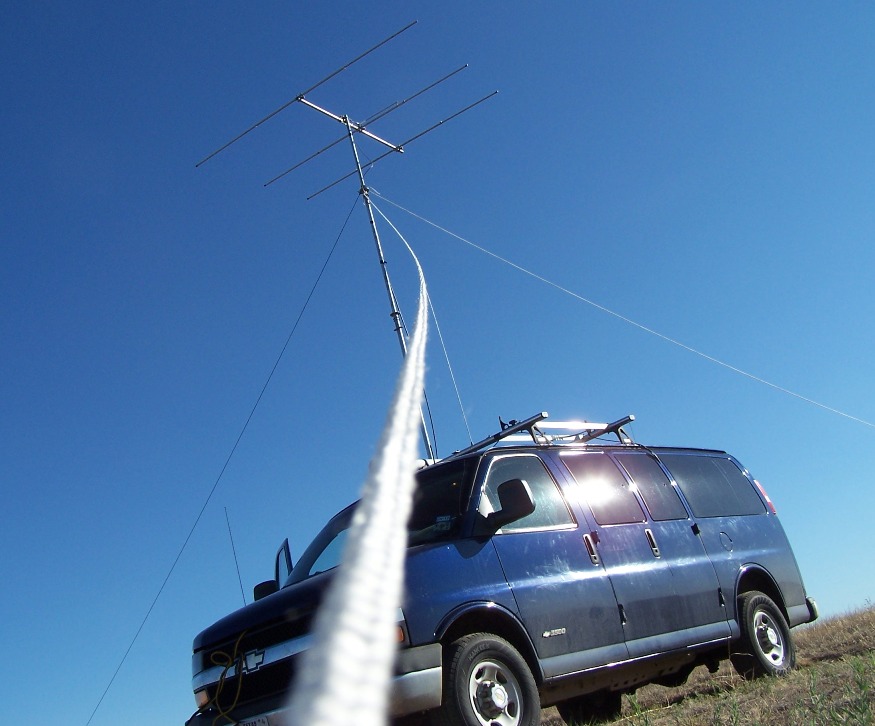
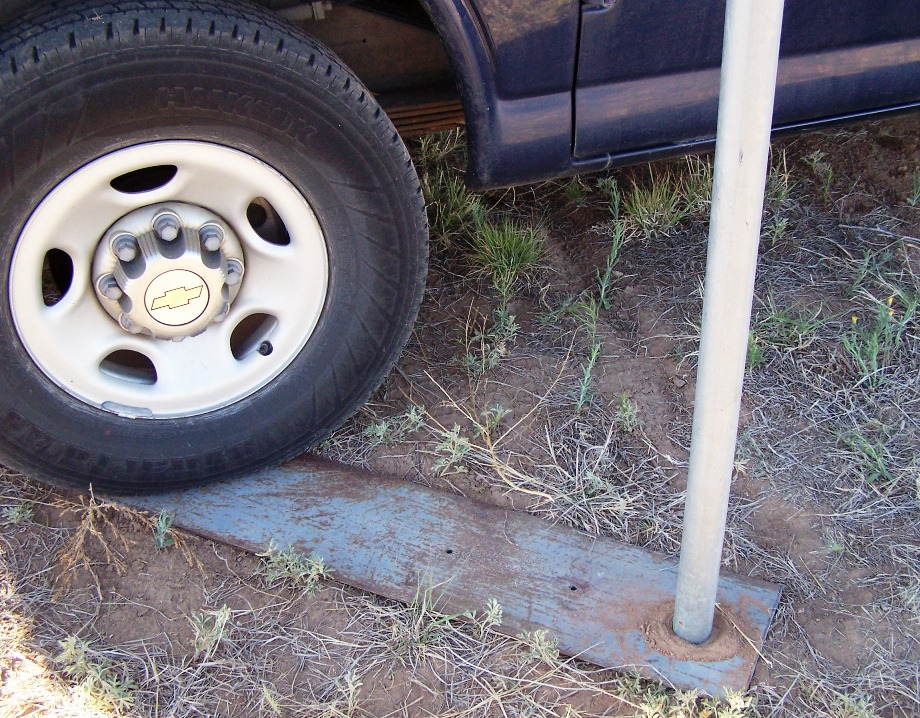
That is a heavy steel plate, with the Rohn H40 mast sitting over a bolt that sticks up through the plate. The mast isn’t bolted to the plate — the bolt just acts as a stub to keep the bottom of the mast from slipping sideways more than an inch. The beam was rotated by hand-turning the mast.
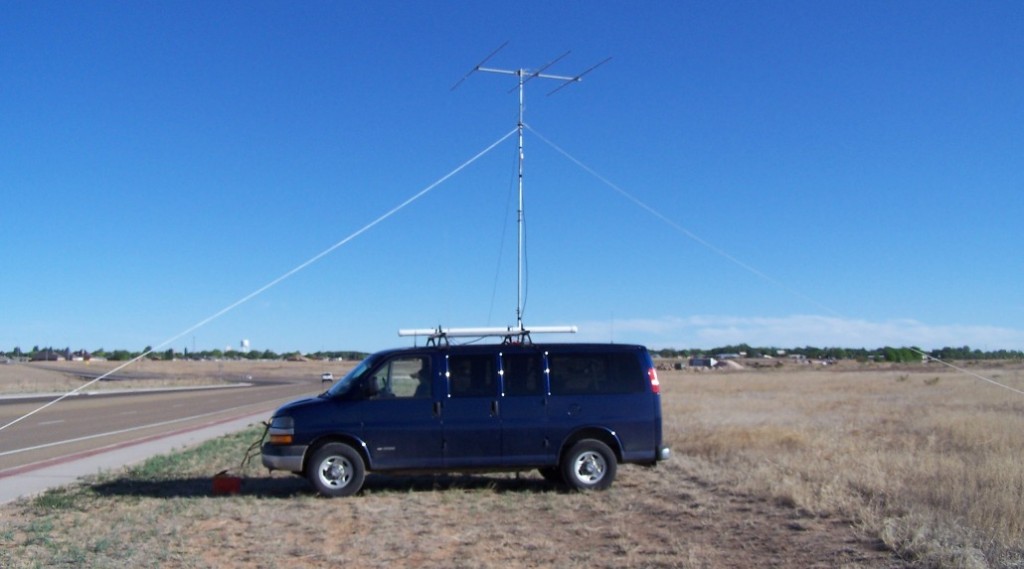
The old 3-element 6-meter beam did OK — not great, but OK. Next time, I hope to also take the 5-element M2 6M5X. The 40′ Rohn mast was extended only up to the 25′ level. The long 3″ PVC pipe on the roof, by the way, is where the hamsticks for HF are stored — but I didn’t even mount one of them this trip…
Videos of grid-expedition setup and GPS:
First, on May 13:
van & area setup (15 sec, 5 mb)
gps lat/long proof (11 sec, 3 mb)
gps date/time proof (7 sec, 2 mb)
video of Sarah KE5CIJ operating while I (N0RQ) took a video of the setup & area (25 sec, 12 mb)
And a couple from the return trip on May 21:
van & area setup (34 sec, 13 mb)
sunrise (31 sec, 7mb)
